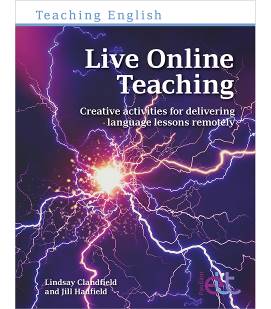‘What is ‘Zoom Fatigue’ and How Does It Affect Language Teachers?
Lindsay and Jill are the authors of Live Online Teaching, published by Pavilion Publishing 2021.


You may have noticed it while teaching over the past two years. You finish a class, stand up, rub your eyes, and feel... really tired. I am of course describing a certain kind of class, the kind of class delivered remotely, online and using a videoconferencing tool such as Zoom, Google Meet or Microsoft Teams.
Since the pandemic began in 2020, millions of teachers and students across the world were thrown into online teaching. Results of this worldwide experiment, in what is now often called ‘emergency remote teaching’, have been mixed. Some viewed it as a lifesaver to be able to continue classes, stay in touch with each other and manage to continue to earn a living. Others have viewed it as a regrettable necessity, a disastrous experiment or at least as further proof that face-to-face learning is much better than online.
In this article we do not want to argue one side or the other, but rather look at one specific consequence for the teacher of moving their teaching into an online, videoconference environment: the fatigue that this specific technology causes.
Zoom fatigue, sometimes called virtual fatigue, refers to the exhaustion people feel after any kind of extended video call or conference. The phenomenon has only recently received attention, usually within the context of business remote work and meetings but more recently in the world of education, undoubtedly because of the high amount of videoconferencing that happened (and is still happening) because of the pandemic.
Psychologists studying the phenomenon attribute Zoom fatigue to causes that are all related to the technology and how we interact with it. Here are three of the main ones, and how they relate specifically to teaching in a live online context.
Seeing yourself during video classes gets exhausting
In an online class, the teacher will have their video on almost all the time, if not the entire time. This means that there is a square on the screen where you see yourself during the whole class. But teaching in this way isn’t natural. Imagine you were teaching your face-to-face classes with a mirror placed right in front of you when you were explaining things, giving feedback, listening to students... it would probably stress you out. In addition, many people are more critical of themselves when they see themselves on video. Having this for many hours a day is quite taxing.

Your mobility is reduced
Think about when you teach a class face-to-face. How often are you sitting down? If you are like us, or any of the language teachers we’ve observed, you are probably spending most of your time standing up. You also walk around. You’re at the board, moving around the front of the class, circulating while students are working, maybe even explaining something from another part of the room at times. In most video classes, you are sitting down in front of your webcam and not moving at all. Aside from hampering your normal way of teaching, sitting for very long periods of time in front of a screen can cause a whole host of other problems.
Furthermore, language teachers particularly make much more use of their body to explain concepts or illustrate things. Unless you have set up a good camera to film your whole body in front of a board then you probably don’t get to move as much as you would instinctively.

Eye contact can get stressful
Psychologists who examine online virtual communication say that the amount of eye contact that happens in video chat, as well as the size of faces on the screen, can become unnatural. Normally when learners are in a class, they will be looking at the teacher, taking notes, glancing at each other, or even gazing out of the window. The teacher will be looking across the class, at the blackboard while writing, down at the teaching notes sometimes and making periodic eye contact. In a video class, with cameras on all the time, everyone is looking at the camera and at each other almost the whole time. The amount of eye contact is increased, which can also become quite stressful for the teacher as well as the learners.
‘But my learners never turn on their cameras!’ we hear you cry. This was by far the most common complaint we heard from teachers doing online video classes. In some ways, this is even more problematic. Having everyone’s eyes on you all the time is stressful but teaching to a series of black boxes on a screen and not knowing if there is anyone there is also frustrating.
So, faced with these problems, what can a language teacher do to help make their live online classes less tiring? The first thing would be to work out a principled approach to the use of the video camera. You may want to make it obligatory for learners to use their cameras, but it needn’t be all the time. Have moments where everyone is on camera, and moments where students individually turn on their camera to do a task. Similarly, for yourself have moments when you turn your camera off to let the learners do something on their own. Or plan parts of the class where you are only using the audio (for example, when explaining something with a slideshow or showing an image).
The other thing you can do is to plan your class so there are moments that you get away from the screen. There has been much research done into the concept of the microbreak for people who work a lot with computers. These are short breaks that allow the user to move their body and focus on something other than the screen for a short while. We began to explore this concept of the microbreak in live online teaching and wrote several activities that we called ‘zooming out’ activities. In our next article, we will share some of them with you.
Please check the Pilgrims f2f courses at Pilgrims website.
Please check the Pilgrims online courses at Pilgrims website
‘What is ‘Zoom Fatigue’ and How Does It Affect Language Teachers?
Lindsay Clandfield, UK;Jill Hadfield, New ZealandUsing Microbreaks in Online Language Teaching
Lindsay Clandfield, UK;Jill Hadfield, New ZealandFlipped Classroom by Edpuzzle in the Context of Freshmen’s Learning ELF
Mai Tran Thi Thanh, VietnamUsing Netflix in the EFL Classroom - An Example
Anna Pereszlényi, Hungary